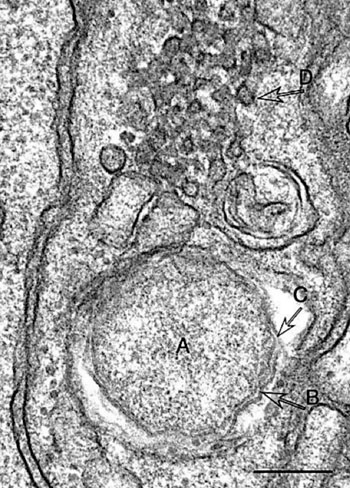New Tick-Borne Disease Threatens Primarily Immune Suppressed Persons
By LabMedica International staff writers
Posted on 16 Jun 2014
A newly discovered tick-borne bacterium known as Candidatus Neoehrlichia mikurensis has been implicated in six cases of the disease in Sweden.Posted on 16 Jun 2014
The bacterium, which is spread by rodents and ticks mainly in Asia and Europe, including Sweden, has been found in 19 cases worldwide and is primarily a risk for people who are already sick and who are receiving immunosuppressive drugs.

Image: Transmission electron micrograph of Candidatus Neoehrlichia mikurensis (A). The arrows indicate the thin, rippled, bileaflet outer membrane which is characteristic of the bacterium (B), the irregular, narrow periplasmic space between inner and outer membranes, also characteristic (C) and canalicular system of the endothelial cell (D) (Photo courtesy of Yasuko Rikihisa).
Scientists at the University of Gothenburg (Sweden) working with their European colleagues compiled clinical and laboratory data from 11 patients with hematological malignances or autoimmune diseases who were diagnosed with Ca. N. mikurensis infection in Europe from 2010 to 2013. The patients had a median age of 67, were mostly male (8/11), and resided in Sweden, Switzerland, Germany, and the Czech Republic. All but one had ongoing or recent immune suppressive treatment and a majority were splenectomized (8/11).
The most abnormal laboratory findings among all the patients was elevation of the acute phase reactant C-reactive protein in serum, with levels ranging from 4- to 74-fold higher than the cutoff level. Leukocytosis with neutrophilia and anemia were also typical findings. About half of the patients had at some point raised levels of lactate dehydrogenase in serum and hyponatremia, respectively. Lowered platelet counts and elevated transaminase concentrations were rare findings.
The diagnosis of Ca. Neoehrlichia infection was in all cases based on pan-bacterial polymerase chain reaction (PCR) analysis of segments of the 16S ribosomal ribonucleic acid (rRNA) gene followed by sequence and homology analyses. Once neoehrlichiosis has been diagnosed, the patients recover completely after treatment with antibiotics. Physicians within the fields of rheumatology, hematology, oncology, and infectious diseases should be aware of this new infectious agent and their attention drawn to patients with suspected recurrence of the underlying autoimmune or hematologic disease where the clinical picture is atypical.
Christine Wennerås, MD, PhD, the senior author of the study said, “The bacterium cannot be grown in culture, and this means that it is not picked up in routine diagnostic procedures. Furthermore, the symptoms are deceptive. Several patients, for example, have been affected by blood clots in the leg or the blood vessels in the head, and this has not been coupled to an infectious cause. Other typical symptom such as fever, muscle pain and joint pain can be caused also by the patient’s underlying disease. We know very little about how the infection affects otherwise healthy people who are not taking immunosuppressive drugs.” The study was published online on March 18, 2014, in the journal Clinical Infectious Diseases.
Related Links:
University of Gothenburg










 (3) (1).png)


